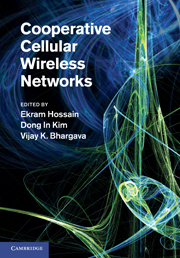Book contents
- Frontmatter
- Contents
- List of contributors
- Preface
- Part I Introduction
- Part II Cooperative base station techniques
- 3 Cooperative base station techniques for cellular wireless networks
- 4 Turbo base stations
- 5 Antenna architectures for network MIMO
- Part III Relay-based cooperative cellular wireless networks
- Part IV Game theoretic models for cooperative cellular wireless networks
- Part V Standardization activities
- Index
5 - Antenna architectures for network MIMO
from Part II - Cooperative base station techniques
Published online by Cambridge University Press: 03 May 2011
- Frontmatter
- Contents
- List of contributors
- Preface
- Part I Introduction
- Part II Cooperative base station techniques
- 3 Cooperative base station techniques for cellular wireless networks
- 4 Turbo base stations
- 5 Antenna architectures for network MIMO
- Part III Relay-based cooperative cellular wireless networks
- Part IV Game theoretic models for cooperative cellular wireless networks
- Part V Standardization activities
- Index
Summary
Introduction
In conventional cellular systems, cochannel interference is a serious issue that degrades system performance. The spectral efficiency of cellular networks is fundamentally limited by the interference between cells and users sharing the same channel for both downlink and uplink. Generally, there are two kinds of cochannel interference: intracell interference and intercell interference.
The intracell interference can be resolved by allocating orthogonal frequency resources. To mitigate intercell interference, there are several general approaches such as frequency reuse, cell sectoring, and spread spectrum transmission. The most commonly used technique is to avoid using the same set of frequencies in neighboring cells. This approach leads to the decrease of the number of available channels within each cell.
Universal frequency reuse, i.e., reuse factor of 1, is preferred for future broadband wireless communications systems, such as the Third Generation Partnership Project (3GPP) long-term evolution (LTE) and worldwide interoperability for microwave access (WiMAX). In the orthogonal frequency-division multiple access (OFDMA) systems, which do not have processing gain as the code-division multiple access (CDMA) system, how to achieve the goal of both universal frequency reuse and reducing intercell interference is a key challenge.
The concept of fractional frequency reuse (FFR) has been suggested to improve spectrum efficiency by applying reuse partition techniques, in which the inner region of the cell is assigned the whole frequency spectrum and the outer region is only assigned a small fraction of the frequency spectrum.
- Type
- Chapter
- Information
- Cooperative Cellular Wireless Networks , pp. 128 - 150Publisher: Cambridge University PressPrint publication year: 2011



